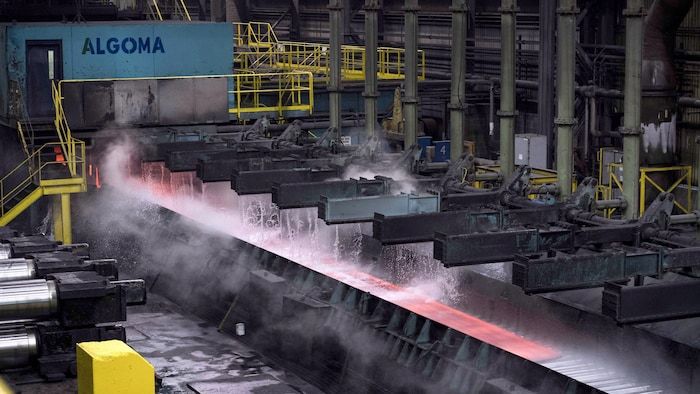More than 22,500 workers from the Ontario manufacturing sector could retire each year until 2033. This is what a report published by the Manufacturers and Exporters Canada (MEC) organization entitled Keep Calm and Keep Training (Stay calm and continue to train).
According to Statistics Canada data, one in four workers from the Ontario manufacturing sector was 55 years old or over in 2024.
The company led by Robert Brouillette, CEO of City Weldingis an example, while it has about 25 % of its workers who are over 50 years old. However, the rest of the workforce is under 40 years of age.

open in full screen
Bill Slater acknowledges that customs tariffs could be the cause of numerous layoffs provided for in Algoma Steel.
Photo : Radio-Canada / Nicolas Mongeon
As for the Algoma Steel steelworks, Bill Slater, president of the local section 2724 of the metallos, reports rather a balance between age groups within the Eciérie staff.
We have many older people, many others also younger, but we have fewer people in the middle age class
he said.
The union president recognizes that it is difficult to predict when older workers will take their pensions since it cannot be imposed on them.
Different realities for the North
The report specifies that the manufacturing sector in northern Ontario experienced an increase in its workforce last year.
Statistics Canada listed a total of 18,100 manufacturing workers in the northeast of the province in 2024, an increase of 4 % compared to the previous year.

Open in full screen
Algoma Steel plans to dismiss around 1,000 employees soon. (Archives photo)
Photo: Canadian press / Justin Tang
However, the analysis reports on many factors that could reduce labor in the region, including personnel retention and customs prices.
Mr. Slater claims that it is possible that the trade war is one of the causes of the dismissal of nearly 1,000 employees planned within the steelworks soon.
Since the transition to the stove with electric arc is done at the same time as the trade war [avec les États-Unis]it is difficult to know what is really the cause
he said.
Vincent Caron, vice-president of government relations for MECrecognizes that the North has trouble attracting workers.

Open in full screen
Vincent Caron believes that the various levels of governments should bet on the formation of the workforce to avoid shortages in the future.
-Photo: Radio-Canada / Orpheus Moussongo
There are populations where we do not have enough people who come to the manufacturing sector. We have heard a lot say that it is not enough to attract workers with jobs, but they must also be attracted to the region
adds Mr. Caron.
Besides, Mr. Brouillette admits that personnel retention is not easy in his region.
We have two large mining companies that generally offer higher wages than small and medium -sized businesses so often we will train who will then work for mines
he underlines.
Training and immigration to attract staff
All these challenges are among the reasons why Robert Brouillette has favored immigration programs for a few years, as main sources of labor.

Open in full screen
Robert Brouillette says that 90 % of the job requests he receives within his business come from immigration from immigration, fresh out of their training.
Photo: Radio-Canada / Orpheus Moussongo
I receive a lot of people who wish to move to the region since we have permanent residence programs
he said.
More than 90 % of the curriculum vitae that I receive come from foreign workers who have just finished their studies […] Canadians already have jobs.
Rather, the report encourages the various levels of government to bet on subsidies and promotions of training in specialized trades, to remedy the shortages of labor and skills, especially at a period when everyone advocates the Made in Canada.
We can be very focused on the short term, the trade war, the uncertainty that it creates for jobs, but it takes time to train people.
If we want to bring back industries and if we want critical minerals to be transformed at home then we will absolutely have to start training, we will have to bring all those people we need to make the factories that we want to open in northern Ontario have people to work there when they open in a few years
stipulates Mr. Caron.

Open in full screen
The Prime Minister of Ontario Doug Ford says he plans hundreds of millions of dollars for training in business specialized in his next budget. (Archives photo)
Photo: the Canadian press / Laura Proctor
The analysis also encourages the various levels of government to subsidize the apprenticeship programs, while it provides for a drop in the number of registrations in the colleges, due to the federal cap of international study permits.
It also perhaps requires government subsidies, whether federal or provincial, to really attract even more people. Our teaching institutions have significant financial problems at the moment. We cannot afford to cut programs in specialized trades […] It is necessary to invest now for the classes to be completed, that the students progress so that they are available in a few years
he concludes.
The Ontario government announced on Tuesday that its next budget will include an investment of $ 705 million, dedicated to labor.
The provincial budget will be deposited on May 15.













